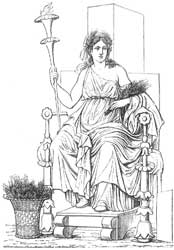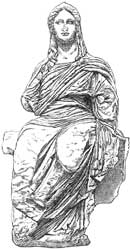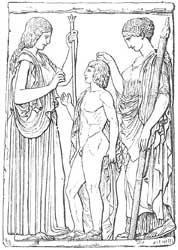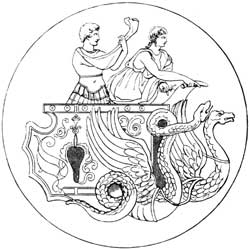Demeter
One of the great divinities of the Greeks. The name Demeter is supposed by some to be the same as γῆ μήτηρ (gē mētēr), that is, mother earth, while others consider Deo, which is synonymous with Demeter, as connected with δαίς (dais) and δαίνμυι (dainmui), and as derived from the Cretan word δηαί (dēai, "barley") so that Demeter would be the mother or giver of barley or of food generally.1 These two etymologies, however do not suggest any difference in the character of the goddess, but leave it essentially the same.

Demeter was the daughter of Cronus and Rhea, and sister of Hestia, Hera, Aides, Poseidon, and Zeus. Like the other children of Cronus she was devoured by her father, but he gave her forth again after taking the emetic which Metis had given him.2
By her brother Zeus, Demeter became the mother of Persephone (Proserpine) and Dionysus,3 and by Poseidon of Despoena and the horse Arion.4 The most prominent part in the mythus of Demeter is the rape of her daughter Persephone by Hades, and this story not only suggests the main idea embodied in Demeter, but also directs our attention to the principal seats of her worship. Zeus, without the knowledge of Demeter, had promised Persephone to Hades, and while the unsuspecting maiden was gathering flowers which Zeus had caused to grow in order to tempt her and to favor Hades' scheme, the earth suddenly opened and she was carried off by Aidoneus (Hades). Her cries of anguish were heard only by Hecate and Helios. Her mother, who heard only the echo of her voice, immediately set out in search of her daughter.
The spot where Persephone was believed to have been carried into the lower world is different in the different traditions; the common story places it in Sicily, in the neighborhood of Enna, on Mount Etna, or between the wells Cyane and Arethusa.5 This legend, which points to Sicily, though undoubtedly very ancient,6 is certainly not the original tradition, since the worship of Demeter was introduced into Sicily by colonists from Megara and Corinth. Other traditions place the rape of Persephone at Erineus on the Cephissus, in the neighborhood of Eleusis,7 at Colonus in Attica,8 in an island of the Atlantic near the western coast of Spain,9 at Hermione in the Peloponnese,10 in Crete,11 or in the neighborhood of Pisa.12 Others again place the event at Pheneus in Arcadia,13 or at Cyzicus,14 while the Homeric hymn on Demeter places it in the plain of Nysa in Asia. In the Iliad and Odyssey the rape of Persephone is not expressly mentioned.

Demeter wandered about in search of her daughter for nine days, without taking any nectar or ambrosia, and without bathing. On the tenth she met Hecate, who told her that she had heard the cries of Persephone, but did not know who had carried her off. Both then hastened to Helios, who revealed to them that Hades had been the ravisher, and with the consent of Zeus. Demeter in her anger at this news avoided Olympus, and dwelt upon earth among men, conferring presents and blessings wherever she was kindly received, and severely punishing those who repulsed her or did not receive her gifts with proper reverence. In this manner she came to Celeus at Eleusis. As the goddess still continued in her anger, and produced famine on the earth by not allowing the fields to produce any fruit, Zeus, anxious that the race of mortals should not become extinct, sent Iris to induce Demeter to return to Olympus.15 But in vain.
At length Zeus sent out all the gods of Olympus to conciliate her by entreaties and presents; but she vowed not to return to Olympus, nor to restore the fertility of the earth, till she had seen her daughter again. Zeus accordingly sent Hermes into Erebus to fetch back Persephone. Aidoneus consented, indeed, to Persephone returning, but gave her a part of a pomegranate to eat, in order that she might not always remain with Demeter. Hermes then took her in Hades' chariot to Eleusis to her mother, to whom, after a hearty welcome, she related her fate. At Eleusis both were joined by Hecate, who henceforth remained the attendant and companion of Persephone. Zeus now sent Rhea to persuade Demeter to return to Olympus, and also granted that Persephone should spend only a part of the year (i.e. the winter) in subterraneous darkness, and that during the rest of the year she should remain with her mother.16
Rhea accordingly descended to the Rharian plain near Eleusis, and conciliated Demeter, who now again allowed the fruits of the fields to grow. But before she parted from Eleusis, she instructed Triptolemus, Diocles, Eumolpus, and Celeus in the mode of her worship and in the mysteries. These are the main features of the mythus about Demeter, as it is contained in the Homeric hymn; in later traditions it is variously modified.

Demeter was the goddess of the earth,17 and more especially of the earth as producing fruit, and consequently of agriculture, whence human food or bread is called by Homer18 the gift of Demeter. The notion of her being the author of the earth's fertility was extended to that of fertility in general, and she accordingly was looked upon also as the goddess of marriage,19 and was worshiped especially by women. Her priestess also initiated young married people into the duties of their new situation.20 As the goddess of the earth she was like the other Δεόι χθόνιοι (Deoi chthonioi), a subterraneous divinity, who worked in the regions inaccessible to the rays of Helios. As agriculture is the basis of a well-regulated social condition, Demeter is represented also as the friend of peace and as a law-giving goddess.21
The mythus of Demeter and her daughter embodies the idea, that the productive powers of the earth or nature rest or are concealed during the winter season; the goddess (Demeter and Persephone, also called Kore, are here identified) then rules in the depth of the earth mournful, but striving upwards to the all-animating light. Persephone, who has eaten of the pomegranate, is the fructified flower that returns in spring, dwells in the region of light during a portion of the year, and nourishes men and animals with her fruits.
Later philosophical writers, and perhaps the mysteries also, referred the disappearance and return of Persephone to the burial of the body of man and the immortality of his soul.

Demeter was worshiped in Crete, Delos, Argolis, Attica, the western coast of Asia, Sicily and Italy, and her worship consisted in a great measure in orgic mysteries. Among the many festivals celebrated in her honor, the Thesmophoria and Eleusinia were the principal ones. The sacrifices offered to her consisted of pigs, the symbol of fertility, bulls, cows, honey-cakes, and fruits.22 Her temples were called Megara, and were often built in groves in the neighborhood of towns.23 Many of her surnames are descriptive of the character of the goddess.
The Romans received the worship of Demeter, to whom they applied the name of Ceres, from Sicily.24
❧
Iconography
Demeter was often represented in works of art, though scarcely one entire statue of her is preserved. Her representations appear to have been brought to ideal perfection by Praxiteles.25 Her image resembled that of Hera, in its maternal character, but had a softer expression, and her eyes were less widely opened. She was represented sometimes in a sitting attitude, sometimes walking, and sometimes riding in a chariot drawn by horses or dragons, but always in full attire. Around her head she wore a garland of corn-ears or a simple ribband, and in her hand she held a sceptre, cornears or a poppy, sometimes also a torch and the mystic basket.26 She appears most frequently on gems and vases.
From the fifth century BCE dates the Demeter by Cherchel and two statues at the Vatican and the Capitoline at Rome which possibly depict Demeter. Famous is the enthroned Demeter of Cnidos (mid-fourth century BCE) and the relief from Eleusis which depicts Demeter and Kore and the youth Triptolemus (Phidias, mid-fifth century BCE). A mural at Pompeii shows the goddess seated on a throne, surrounded by ears of corn, a torch in her right hand and ears of corn in her left.
References
Notes
- Homer. Iliad v, 500.
- Hesiod. Theogony, 452 ff.; Pseudo-Apollodorus. The Library i, 2.1.
- ibid., 912. Diodorus Siculus, iii, 62.
- Pseudo-Apollodorus. The Library iii, 6.8; Pausanias. Description of Greece viii, 37.6.
- Hyginus. Fabulae, 146, 274; Ovid. Metamorphoses v, 385; Ovid. Fasti iv, 422; Diodorus Siculus, 3; Cicero. In Verrem iv, 48.
- Pindar. Nemean Odes i, 17.
- Orphic Hymn 17, 15.
- Scholiast on Sophocles' Oedipus at Colonus, 1590.
- Orphic. Argonautica, 1190.
- Pseudo-Apollodorus. The Library i, 5.1; Strabo. Geography viii, 373.
- Scholiast on Hesiod's Theogony, 914.
- Pausanias. Description of Greece vi, 21.1.
- Conon. Narratives, 15.
- Propertius, iii, 21.4.
- Comp. Description of Greece, viii, 42.2.
- Comp. Metamorphoses v, 565, Fasti iv, 614; Hyginus. Fabulae, 146.
- Euripides. Bacchae, 276.
- Homer. Iliad xiii, 322.
- Servius on Virgil's Aeneid iv, 58.
- Plutarch. De Off. conj., 1.
- Callimachus. Hymn to Demeter, 138; Orphic Hymn 39, 4; Virgil. Aeneid iv, 58; Homer. Iliad v, 500; Ovid. Metamorphoses, 341; Pausanias. Description of Greece viii, 15.1.
- Macrobius. Saturnalia i, 12; iii, 11; Diodorus Siculus, v, 4; Pausanias. Description of Greece ii, 35.4; viii, 42, in fin.; Ovid. Fasti iv, 545.
- Pausanias. Description of Greece i, 39.4, 40.5; vii, 26.4; viii, 54.5; ix, 25.5; Strabo. Geography viii, 344; ix, 435.
- Valerius Maximus, i, 1.1.
- Pausanias Description of Greece i, 2.4.
- ibid. iii, 19.4; viii, 31.1; 42.; Pliny the Elder. Naturalis Historia xxxiv, 8. s. 19.
Source
- Smith, William. (1870). Dictionary of Greek and Roman Biography and Mythology. London: Taylor, Walton, and Maberly.
This article incorporates text from Dictionary of Greek and Roman Biography and Mythology (1870) by William Smith, which is in the public domain.